|
- HISTORY OF THE UPPER KEYS -
The Early Evolution of the Key West Extension - 1893 - By Jerry Wilkinson - Compilation
date = July 2011
- Introduction -
To get into the mind of Henry Flagler was impossible when he was alive
and more so today. There are three books written about him as well as
numerous newspaper articles and how accurate any of them are, is
questionable. The books are
Flagler: Rockefeller -
Partner and Florida Baron, by Edward Akin; Henry Flagler by David
Chandler; and Florida's Flagler
by Sidney Martin. As for the
newspapers, Flagler either owned, or had controlling financial
interest in many Florida newspapers; therefore, this should be
considered. At the same time, Flagler and Randolph Hearst were at odds
end, therefore, Hearst owned newspapers were subjective.
I was raised with an interest in Henry Flagler as my Grandmother, who had adopted me, despised him for divorcing his second wife, Ida Alice. Hardly a week would pass that Flagler's name was not compared with some contemporary rascal, always in the negative perspective. For my brief biography of Flagler's life please go to: http://www.keyshistory.org/flagler.html. or Click Here. My subject is the Key West Extension, but first a little about its owner/builder. I will proceed more or less in a chronological order. Henry Flagler's first visit to Florida was with his first wife, Mary and eight year old son Harry in 1878 at Jacksonville. She had tuberculosis and the doctors thought the warmer winters would help her. Flagler despised the poorly developed living amenities in the state of Florida; therefore, they only stayed a few weeks and returned to New York - Flagler regretted this selfish move all his life. Mary died three years later - 1881. Flagler married his second wife in June 1883. For a honeymoon they visited Florida again, but chose St. Augustine in December 1883 and remained until March 1884. While there, he met a Dr. Andrew Anderson who became his local agent. The Flagler's made plans to return and did so in February 1885. In the end, Flagler acquired most of downtown St. Augustine to build three hotels. He knew that drastically improved transportation services for his hotels had to be made for potential customers for access. In December 1885, Flagler bought the controlling stock in the Jacksonville, St. Augustine & Halifax River Railway, and made himself president. Then he bought one half of the one year old J.T.& K.W. Rwy. Co. and other short-line rail companies. Rail service from the city of Jacksonville across the St. Johns River to St. Augustine was not only for hotel customers, but for supporting hotel construction and future operations. In St. Augustine, the Ponce de Leon hotel was opened January 10, 1888. Following were the Cordova and the Alcazar hotels which were opened in 1889. These three St. Augustine hotels catered more or less to the filthy rich, the very rich and the rich. Mr. Flagler was in the hotel business. In the petroleum business, the Sherman Anti Trust Act was enacted in 1890 and Flagler began to inch his way out of the day to day Standard Oil operations allowing more time for the hotels. For a Florida family home, he built at Saint Augustine one with the name 'Kirkside.' -
The Key West Extension
-
Hoping that the above short introduction has
established a need for Flagler to also be in the railroad
business, let's move to year 1893.
In 1893,
the Florida Legislature to encourage more transportation facilities
and passed a new act increasing land grants from 3,840 to 8,000
acres
per mile of new railroad constructed south of the City of Daytona.
Flagler almost
immediately created a new
railway company - his company and not one bought from others owners.
Its name
was the Jacksonville, St.
Augustine, and Indian
River Railway
Company. 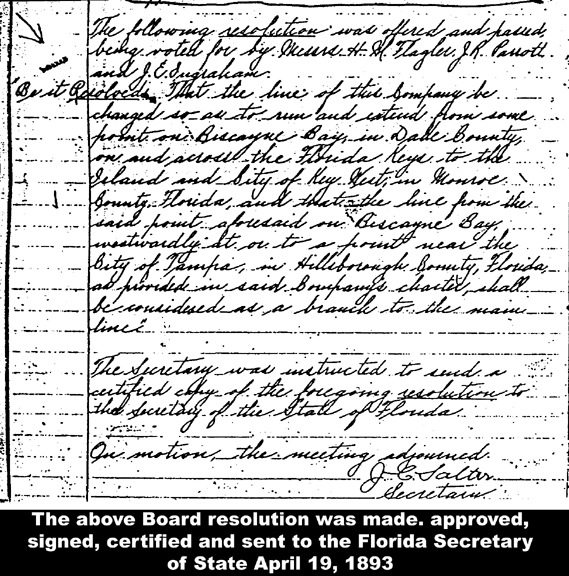 He appointed J.A. Parrott and J.E. Ingraham whom he had
employed in 1892 as corporate directors. He appointed J.A. Parrott and J.E. Ingraham whom he had
employed in 1892 as corporate directors. One of the first things he did was to pass a single item company resolution to build a railroad line to Key West! Therefore, it was 1893 when he seriously decided to build a railroad to Key West. This was not an illogical move as in 1880, Key West was Florida's largest populated city 9,890 people. By 1910, it was third with about 17,000, second was Pensacola at 18,000, first was Jacksonville. with 28,249. A copy of the important part - the only agenda item - of the April 19, 1893 minutes is at the right and click to enlarge. For an easier read transcription, the entire minutes follow;
"Meeting
of the Board of Directors
of the Jacksonville,
St. Augustine and Indian River Railway Company, duly called, was
held at
the office of the President, the nineteenth day of April, A.D. 1893 at
St.
Augustine, Florida, Present:
Messrs:
H.M Flagler J. A. Parrott J.E. Ingraham. The minutes of the last meeting were read and approved. The following resolution was offered and
passed being
voted for by Messrs. H.M. Flagler, J.R. Parrott and J.E. Ingraham. The
Secretary was instructed to send a
certified copy of
the foregoing resolution to the
Note 1: That he named the starting point of
the
extension of his rail company to Key West as "Biscayne Bay in Dade
County." Did he not already have Fort Dallas (Miami) in his 1893 plans?
Secretary of the State of Florida. On motion the meeting adjourned. J. C. Salter Secretary” Note 2: Ten days later, April 29, 1893, State Senator Browne of Monroe County using almost the same text as above in its preamble pushed a bill through the Florida Senate granting the rail company 8,000 acres for each mile of track below Daytona. Building a railway to Key West was not a novel idea and Flagler was not the first to consider a railroad to Key West. The Key West Gazette newspaper pictured it in 1835. Again in 1835 the Key West Inquirer promoted it. U.S. Senator Stephen Mallory advocated a railroad's advantages to the nation in 1850. Civil Engineer J.C. Bailey ran a survey route over the Keys with the International Ocean Telegraph Company in 1866 while running the telegraph line to Key West. Florida granted former Confederate General John Gordon the first charter in 1883, but Gordon only built a few miles and withdrew his efforts. Others were considering the route, but Flagler was friends with Key West's State Senator, Jefferson B. Browne, (1891-1893) who later supported the actual railroad state charter. This 1893 resolution announced his preemptive position and others knew that he had the finances to act at his will. In 1896, the National Geographic Magazine published an article titled "Across the Gulf by Rail to Key West" closing with a tribute to its probable builder, Henry M. Flagler. The year 1893 is far earlier than all the other dates describing this monumental decision to build a railway to Key West, and looking at national and international ongoing events in 1893 ponders the motivation to build a railroad through a jungle and over water. Water was not a problem evidently as his first option included a bridge from East Cape Sable to No Name Key. The Seven Mile Bridge would have been a micro-bridge compared to that bridge! My estimate using Google Earth, is the bridge would have been about 26.6 miles long. For trivia, the Jiaozhou Bay Bridge in Eastern China is 26.4 miles long (2011). In actuality, building a bridge to Key West was not much different from what he was then doing to get to Palm Beach, except for the open expanse of water. At the time of the aforementioned JSA&IR company's resolution, he was extending his hotel/railroad business southward to Palm Beach. An article in the Railroad World of 1895 speculated the extension when Flagler obtained much land on the Island of Key Largo. Mr. Flagler was serious about hotels and it should be obvious it included the east coast of Florida. His rail line along the east coast was referred to as the East Coast Line (ECL). He built an entire city of West Palm Beach just to build and support his new Royal Poinciana Hotel - the largest hotel in the world. Then he built the second hotel on Palm Beach, the Breakers, a stone's throw away. Of course, Flagler, a true micro manager, had to approve each individual project, as he would for all the stepping stones to Key West . In 1893, for the affluent northern family to have a winter vacation at a sunny beach, he/she had to take a month's long steamboat voyage to Europe and perhaps some trains to arrive at eastern France or Italy on the Mediterranean coast. Then there was a repeat trip to return to come back home and to work; therefore, three months time for about one month of vacation. Flagler's idea was to make the much closer sunny beaches of south Florida, only 24 hours away, accessible. The trip to Florida would be much less than half the cost of traveling to Europe. The idea might even prove successful if the hotels had equal amenities. Flagler made certain of that and perhaps even better: electricity, elevators, hot and cold running water, and plenty of booze and gambling - an American Riviera with parlor/pullman rail car service. In this sense, he made Florida what it is today. I overhear statements that the Key West Extension never turned a profit. The question can be asked if his hotels ever turn a profit being open only four months a year with a staff from 1200 to 1400? Profit may have been a motive, but in the Flagler writings, profits are not found. Later we will see that he rejected the Cape Sable route to Key West, but there are no indications that the dollar cost was the reason. To determine profit for a corporation, one must also look at the balance sheet for total assets. Land is an important asset and Flagler was rich in land. I am not saying they does not exist, but I have never found any statements of finances of any of the Flagler companies. The parent company, The Flagler System, had many companies. A new company "Florida East Coast Railway Co." was created by Flagler in 1895 to consolidate all his smaller railway companies and he had many. Also in 1895 was when his son, Harry, left for New York. Harry would later marry, Anne Lamont, and devote his life to his music interests. Harry had had various company positions, even in the railroads and in many of his father's other businesses. Financially, he was well cared for by his father. They never met again until his death bed and then his father was unconscious. Moving forward in time, the 1895 Palm Beach project seemed to garner most of Flagler's attention, but with time it wandered southward - whether the 1893 resolution came to mind is not known. This should come as no surprise as in his 1893 resolution stated that the Key West line would "...extend from some point on Biscayne Bay in Dade County...." Fort Dallas, Coconut Grove and Cuter would be good choices. The following inducements seemed almost too good to refuse when Mrs. Tuttle offered 100 acres for a hotel, plus alternate portions of 540 acres of her remaining land. At the same time, Mrs. Brickell offered 320 acres on the south side of the Miami River. A third inducement was the *Florida Coast Line Canal Company, of which Flagler was president of, offered another 1,500 acres per mile, so off to Fort Dallas (Miami) he went with the Royal Palm Hotel opening in 1897. *The Florida Coast Line Canal and Transportation Company (FCLCTC) was chartered in 1881 to construct a series of canals connecting existing lakes and rivers between St. Augustine and Lake Worth, Florida. Henry Flagler became associated with the company in order to help extend his railroad to the south of the state. Many destination extensions to the FCLCTC were later made within the scope of the original charter. This was the forerunner of the Intracoastal Waterway- JW] To support those claiming hotels were his motivating interest, in 1897 and 1898 he built in the Bahamas the Hotel Victoria and the Hotel Colonial and purchased the Hotel Cartagena; thereby, taking control over the high-end Bahamian tourist industry. This also required the creation of the Florida East Coast Steamship Company with three ships operating in 1899. Parrott became its president and then the president of the FECRwy in 1901. Hotels just may have been an important motive in his mind, but it should be noted that he did not build a hotel at Key West. I did not lose my faith if Flagler's intent to go to Key West even with all the above Bahamian holdings. He was temporarily blocked from going southward by the existing Perrine Grant. Here is s short explanation of the Perrine Grant. Dr. Henry Perrine was killed in 1840. Congress had granted him one Township, 36 square miles, before his death for Tropical Plant Company in the Cape Sable area. After his death, the heirs had the grant moved to southeastern Dade county. The grant requirements had never been satisfied, but the land reserved. If you lay a scaled 36 mile square piece of paper on a map of south east Dade County, a south bound railroad must traverse within the boundaries of the Perrine Grant. Flagler kept attorneys assigned to assist the Dr. Henry Perrine heirs for the 36 square mile southeast land claim from Congress. The Flagler attorneys followed to the Supreme Court which ruled an appropriate division of lands to the railroad, settlers, and Perrine family members in 1898. With this decision, Flagler now had his right-of-way property when and if he decided to make his move further south. Flagler's financial interests remain more or less a secret. Money is seldom mentioned and loans are not either; although I feel certain there were some using his Standard Oil Shares as collateral. From all the writings, he never sold a share of his Standard Oil stock. I will comment on a statement written by author Edward Akin on page 144 if his book of Flagler that stays in my mind. This was in regards to an insinuated speculative policy to pay $45,000 for land to build the City of West Palm Beach. Aiken wrote: "... as a matter of profit, I think I can make more in one week in Wall Street than I can make in one year in real estate in Florida." He was second only to John D. Rockefeller in ownership of Standard Oil Stock and he remained on the Board of Directors until I believe 1909. I assume he made inter/intra company fund transfers within his many holding companies for his operations. As we are addressing hotel interests, obviously there was not a hotel motive in Flagler's Key West plan. The now presence of his steamship company would be a Key West incentive, especially after merging his company with Henry Plant's steamship company in 1901 - I personally would think it would almost be a must. Hotel wise, Flagler did in 1901 add another hotel at Atlantic Beach on Jacksonville Beach - the Continental. This was supposed to be a 'summer Palm Beach', but it was never profitable by his own admissions. That pretty much covered the east coast of Florida from Jacksonville to Miami with hotels, but never one at Key West. Why did Flagler apparently stall his southward movement at Miami? One reason was his involvement with the Bahamas and the Jacksonville Beach hotel. One other thing most likely was lack of incentives. There were no Brickells or Tuttles in the Keys as well as no sandy beaches along the route, but once there, a very deep and natural seaport was something that only Jacksonville had. By 1901, Flagler had merged his steamship company with Henry Plant as the P & O Steamship line. Plant was already connected to Havana, Cuba and Flagler never objected to that. Now that I have mentioned Cuba, please allow a change in subject. There is little known of Flagler's associations with Cuba. The aforementioned three Flagler authors - Aiken, Martin and Chandler - write about his association with Sir. William Van Horn who had Canadian and Cuban railroad holding beginning in 1894. Briefly, Aiken on page 169 writes, "...he had large investments in Van Horn's Cuba Company....", Martin on page 205 writes, "...he had bought some shares in several Cuban railroads.", and Chandler on page 213, "....After his conversations with Van Horn, Flagler reportedly began the consideration of a car-ferry link between Key West and the Cuban railroads, with connections in Miami. It was said he was not preoccupied with making money on the venture." Back to our theme, one thing that hinders my theory of his determination to go to Key West was a codicil in his 1901 signed Last Will and Testament - he forbade railway funds to be used south of Miami, Florida. With that said, in early 1902, he had an Mr. E.C. Frederick's do a preliminary survey for a Cutler Railroad Extension to the Homestead/Redlands area through his Perrine Grant acquired lands. From this point forward there has been significant primary documentation obtained from the Krome family for researchers in the local libraries and museums. Flagler's staff followed the preliminary survey by hiring professional engineer, William J. Krome, in 1902 to perform an engineering survey from some point near his Miami Royal Palm Hotel to present-day Homestead, Florida. At that point, Krome was to turn westward with an exploratory feasibility survey to Cape Sable. The thinking was, if feasible, the rail route would be extended to No Name Key, then to Key West. In p 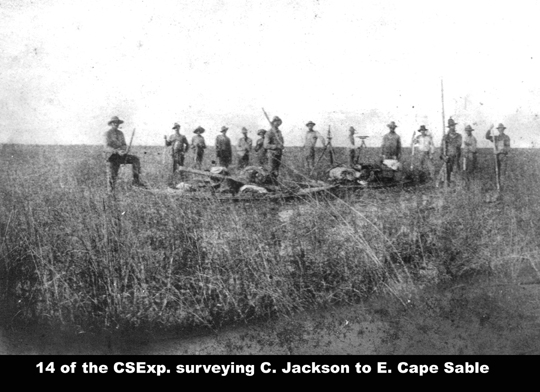 passing
let's mention
that Flagler owned large land parcels of Cape Sable from previous
Florida
railroads and Florida Canal granted lands. If interested in the
details
of this survey I have a detailed description at Click Here.
Warning- it is quite lengthy! The photo at the right is an example. A piece
of trivia: East Cape Sable is the southernmost point of mainland in the U.S. passing
let's mention
that Flagler owned large land parcels of Cape Sable from previous
Florida
railroads and Florida Canal granted lands. If interested in the
details
of this survey I have a detailed description at Click Here.
Warning- it is quite lengthy! The photo at the right is an example. A piece
of trivia: East Cape Sable is the southernmost point of mainland in the U.S.If the Cape Sable route had been chosen, it is possible that points south of Homestead to Big Pine Key would have had a considerable delay before the highway would have been constructed. However, we can imagine that the U.S. signing a treaty in 1903 with Panama for the Panama Canal was plenty of incentive for a visionary like Flagler. The U.S. Senate voted in favor in 1902 with certain provisos for the canal. The Panama Canal concept, as a motive, was repeated numerous times in later newspaper articles, but other positive motives were offered. Krome returned from Cape Sable to Miami in June 1903 with mostly reasons why not to use the East Cape Sable route and definitely not Middle or North Cape Sable. In late January 1904, Krome was employed to survey a rail route across Key Largo to Turtle Harbor in Hawk Channel which is off of North Key Largo in the Carysfort Reef area. This was to construct an ocean terminal similar to Henry Plant's in Tampa Bay that provided the military support for the Spanish American War of 1898. He was also to do a preliminary survey to Cross Key at the same time. In his 1904 diary this is confusing, but I am about to present the high points of the Turtle Harbor and Cross Key controversy. From his 1904 diary with page numbers shown, Cross Key is about US-1 mile Markers 107 to 118. I do not include the entire pages. His 1904 personal diary has 366 handwritten pages. "January 29, 1904 - Page 29 - [At St. Augustine]- “I went down to office for a while this morning and while there had a confab with Mr. Parrott. The latter wanted me to run a line from Homestead across the front to Key Largo, explore a harbor known as Turtle Harbor there, and then run the line to the lower end of the key. Of course I was glad to get the job although mosquito time is coming on…. ” March 29, 1904 - Page 89- [At St. Augustine]- “…from something Ben Carter said this morning, I judge the objective point on Key Largo will be South of where I headed for Turtle Harbor. They may mean Key West….” April 17, 1904 - Page 108- “I arrived in St. Augustine and went to office Mr. Carter - was not there and Mr. Parrott has not returned from Washington. From what Mr. Carter says we were probably go ahead with Key West as our destination and not Turtle Harbor….” April 30, 1904 - page 121- [At Miami]- “Worked up an estimate (my approximation) comparing the route via Little Card Point with that by way of Cross Key. It is all in favor of Cross Key by $150,000 and 3 miles of line. That dooms Turtle Harbor and I hate that idea, but it can't be helped….” July 6, 1904 – Page 188- “Arrived in San Augustine at 7:15 AM. Had a short talk with E. Ben Carter…. “”…He says finish location on Cross Key and then proceed to Bahia Honda to make examination….” The summary is Flagler forgot about a Cape Sable and a Turtle Harbor route and approved surveying the stepping stones Florida Keys to Key West. Something seldom discussed is at Key West he had only a few land parcels, but no land suitable for a rail/shipping terminal. His decision was to dredge in 174 acres of harbor bottom to create what will become known as Trumbo Island/Point. This operation will become a stumbling block in 1907. 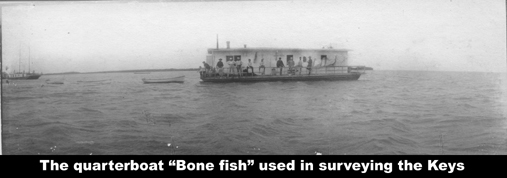 Krome formed three survey teams to work at both ends and the middle of the approximate 126 mile route. Later in July 1904, Flagler hired as his Chief Engineer, Joseph Meredith, which alone indicated that this would more than just another survey. They used the small quarterboat 'Bonefish' as living quarters and office space as well as other sea craft. The when and how the actual construction began, the reader will have to choose his/her favorite story. It had to be a state charter, so there are some facts for the legal approval and the actual construction. First the legal facts: What is a fact is that Florida Senator, E. C. Crill, of Palatka, pushed through bill number 11, granting certain rights and privileges for a railroad to the F.E.C. Rwy. The act became effective May 3, 1905. Now for construction: What is factual is that copies of William Krome's field reports do not give a specific data until August 12, 1905. The date construction began appears to be between April and July of 1905. All are based on a route of a group of approval centerline blueprints on "April 1905," and signed by Engineer Meredith. The earliest date that I can find in copies of the typed FECRwy Annual 'Valuation Section Construction Report to June 30th, 1906' states the Dredge Manetto: "...worked 5 weeks, October 14, 1905 to December 2nd, 1905...." Of course I do not have all records, but my first handmade-handwritten construction report was for the week of August 12, 1905. This was a very basic letter type report, but in group of activities. From this week on, the reports become more sophisticated. The one for: "Week ending September 30, 1905." Costs are listed for Clearing, Grubbing, Drilling, Blasting and Grading" in blocked rows and columns. However, in one of Krome's handwritten field reports to Meredith, I read in a March 23, 1905 report that he stopped at the dredge Manetto to notify Mr. Richmond of a change in route, etc. On June 30, 1905, page 153, Krome sent a handwritten report to Meredith describing conditions of the "Construction Camps," the mosquito problems, morale, equipment mechanical problems, etc. Then a hand drawn report of drilling, blasting, grubbing, clearing by Construction Site number was submitted and dated August 19, 1905, page 163. Anyway it is safe to say that it began in 1905. Work was being done throughout the Keys. At the southern end, I have seen various dates from 1908 to 1910 when the Key West Terminal was to be completed. What I suspect, projects in "Hurricane Alley" should have hurricane clauses in their contracts. Based on past Florida hurricane history, in 1905 few would have expected three hurricanes to interrupt the project in the following six years. Using NOAA's Climatology Series 6-2 publication the last hurricane to have contacted the Key was 1878. There were tropical storms in 1888, 89, 91 and 95, but no hurricanes. From official writings it is difficult to establish the costs and delays of the 1906, 1909 and 1910 hurricanes caused. After the 1906 hurricane and Quarterboat 4 breaking its mooring near Long Key, the precautions alone would have caused some delays. The Annual FECRwy Construction Reports only mentioned the 1909 Hurricane as causing doubts in using native rock (rip-rap) as protection of slopes and the fact that it washed out all the earthen fill of the approach to the Key West Terminal. 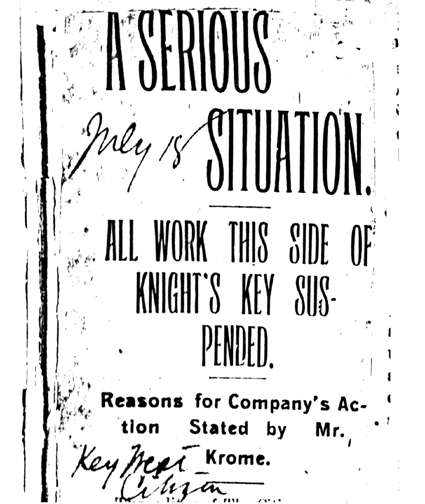 One substantial time delay seldom mentioned that probably would not have been projected in 1893, was the U.S. Navy shutting down all dredging for the Key West Terminal landfill. I doubt that Flagler not owning any acreage in Key West for a major terminal was a consideration in the 1893 resolution. He may have never seen Key West and not realized the lack of available space. When the 1900's came and the evaluations of having to dredge and fill 174 acres of new land, allow it to stabilize and to construct as a huge terminal attached to the Island of Key West were costly and time consuming. All work was proceeding well, until the Navy decided that it might need all the submerged land in the northern harbor for future use. See Key West Citizen article above- right dated July 18, 1907. From what we have to judge from, Flagler just shrugged his shoulders, closed his Key West offices and sped up the opening of Knight's Key Dock. I personally think, and this is only my opinion, he faked it and let the powers-at-be of  Key West deal with the
Navy. What I have no way of knowing was his dealings with the War
Department, as the War Department needed his train system much more
than the submerged fill. The future proved this true as the Navy would
have
been hurting in WW-I and WW-II without Flagler's Trumbo Point.
One point, Flagler did not curtail the construction of the Bahia Honda
Bridge, which was totally not needed if KKD was adequate. Above is an
enlargeable thumbnail
section of small part of a February 5, 1908 Miami Herald article that, if it
is readable, is interesting - one really needs the entire article to
make sense.
Marathon should have celebrated this event four years ago. The article
describes tbe first train over the Key West railroad. Note it does not
describe it as The Key West Extension as I believe that the media had
not yet picked up this usage. Key West deal with the
Navy. What I have no way of knowing was his dealings with the War
Department, as the War Department needed his train system much more
than the submerged fill. The future proved this true as the Navy would
have
been hurting in WW-I and WW-II without Flagler's Trumbo Point.
One point, Flagler did not curtail the construction of the Bahia Honda
Bridge, which was totally not needed if KKD was adequate. Above is an
enlargeable thumbnail
section of small part of a February 5, 1908 Miami Herald article that, if it
is readable, is interesting - one really needs the entire article to
make sense.
Marathon should have celebrated this event four years ago. The article
describes tbe first train over the Key West railroad. Note it does not
describe it as The Key West Extension as I believe that the media had
not yet picked up this usage.In interest of presenting a better representation, the U.S. Navy did find a need for some of the Key West North Harbor bottom materials at the beginning of WW-II. As the Navy base enlarged the need arose to service, stow, test, and maintain ammunition supplies. Fleming Key was an a obvious location and had been military reserved land since an presidential Executive order of August 11, 1924 - long after the Flagler incident. Dredging and construction operations began in July 1941 and more or less completed by the Mackle Leech Construction Co. in January 1942. It is a long story but with the December 7, 1941 Pearl Harbor bombing it continued with addition of depth charges provisioning and access bridge, security facilities, etc. I am not certain other than the Key West Waste Water Treatment facility what is there today (080111). The total time that this event delayed the opening of the Key West Extension at Key West is debatable as some of the equipment and personnel were simply transferred to the Upper and Middle Keys. It definitely sped up the opening of the railroad to Knight's Key Dock. Flagler operated the railway 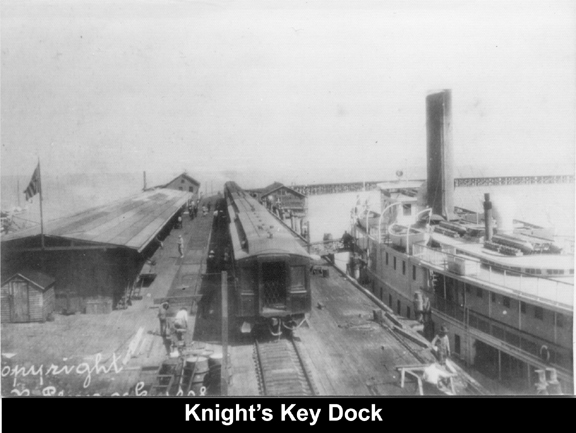 at
Knight's Key Dock (KKD) from January
1908 to 1912 with daily two-way rail and ship passenger and freight
service. The photo above only show one half of the terminal as it
could
handle two ocean going ships and two full passenger trains
simultaneously. For more details of the Knight's Key Dock: Click Here. at
Knight's Key Dock (KKD) from January
1908 to 1912 with daily two-way rail and ship passenger and freight
service. The photo above only show one half of the terminal as it
could
handle two ocean going ships and two full passenger trains
simultaneously. For more details of the Knight's Key Dock: Click Here. With the Knight's Key Dock in operation, the Marathon and the Upper Keys had scheduled daily passenger and freight rail service. One thing Flagler could not have done well at KKD was operate his future rail car ferry service to/from Havana unless he built a complete separate facility. He did this at Key West, but he had 174 acres of land to use. Most national media articles had the trains continuing on to Havana on the proposed train car ferries. When the ferries became operational in 1915, only freight cars were sent to Havana, and the passengers rode the P&O Steamers, e.g., Governor Cobb. Now we are preparing to celebrate the opening of the Key West Extension at Key West 100 years ago this coming January 22, 2012. 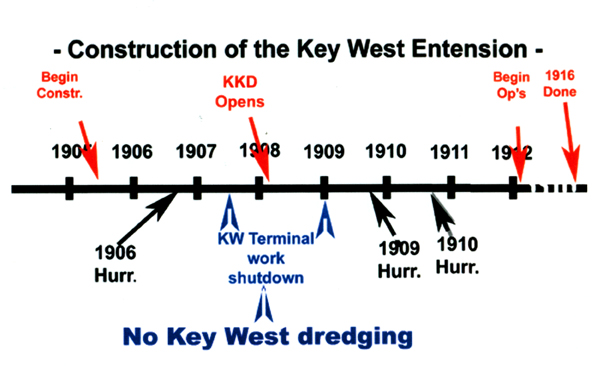 Is should be mentioned that January 12,
2012
was not 100 years since its completion.
Again we have to define when it
was completed. It can be argued that it was never completed as it was
constantly being
worked on. I can say that the last official Annual FECRwy Construction
Report
that I can locate is dated June 30th, 1916. The 1912 date was only
having it safe to operate - an operational date. Many of the bridges,
such as the Channel 2
and Channel 5 bridges were a series of seven wooden trestles. By
1916, the FECRy had 522 miles of mainline from Jacksonville to Key West
and 217 miles of branch lines. The Model Land Company of the Flagler
System place a claim, of 2,050,000 acres of land in Florida. Florida
did not have that much qualifying surplus land and the Model Land
Company settled for 260,000 acres in Palm Beach, Broward and Dade
counties - 210,000 acres were in the Cape Sable/Everglades area. Is should be mentioned that January 12,
2012
was not 100 years since its completion.
Again we have to define when it
was completed. It can be argued that it was never completed as it was
constantly being
worked on. I can say that the last official Annual FECRwy Construction
Report
that I can locate is dated June 30th, 1916. The 1912 date was only
having it safe to operate - an operational date. Many of the bridges,
such as the Channel 2
and Channel 5 bridges were a series of seven wooden trestles. By
1916, the FECRy had 522 miles of mainline from Jacksonville to Key West
and 217 miles of branch lines. The Model Land Company of the Flagler
System place a claim, of 2,050,000 acres of land in Florida. Florida
did not have that much qualifying surplus land and the Model Land
Company settled for 260,000 acres in Palm Beach, Broward and Dade
counties - 210,000 acres were in the Cape Sable/Everglades area.According to Bill Krome, William J. Krome continued to the the Chief Engineer until 1918, when he returned to Homestead as full time attendant of his groves. I admit that I do not have a completion date of the FECRy. Perhaps, this celebration will uproot some documentation for that date. Jerry
Wilkinson
- The Past Explains the Present - |
